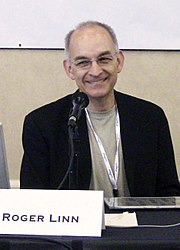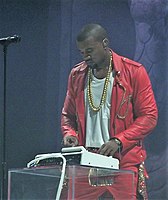This is an old revision of this page, as edited by LunaEclipse (talk | contribs) at 14:36, 29 May 2024 (Rescuing 11 sources and tagging 0 as dead.) #IABot (v2.0.9.5). The present address (URL) is a permanent link to this revision, which may differ significantly from the current revision.
Revision as of 14:36, 29 May 2024 by LunaEclipse (talk | contribs) (Rescuing 11 sources and tagging 0 as dead.) #IABot (v2.0.9.5)(diff) ← Previous revision | Latest revision (diff) | Newer revision → (diff)Music workstation
 An Akai MPC60, the first MPC model An Akai MPC60, the first MPC model | |
| Other names | MIDI Production Center, Music Production Controller |
|---|---|
| Classification | Music workstation |
| Inventor(s) | Roger Linn |
| Developed | 1988 |
The Akai MPC (originally MIDI Production Center, now Music Production Center) is a series of music workstations produced by Akai from 1988 onwards. MPCs combine sampling and sequencing functions, allowing users to record portions of sound, modify them and play them back as sequences.
The first MPCs were designed by the American engineer Roger Linn, who had designed the successful LM-1 and LinnDrum drum machines in the 1980s. Linn aimed to create an intuitive instrument, with a grid of pads that can be played similarly to a traditional instrument such as a keyboard or drum kit. Rhythms can be created using samples of any sound.
The MPC had a major influence on the development of electronic and hip hop music. It led to new sampling techniques, with users pushing its technical limits to creative effect. It had a democratizing effect on music production, allowing artists to create elaborate tracks without traditional instruments or recording studios. Its pad interface was adopted by numerous manufacturers and became standard in DJ technology.
Development

By the late 1980s, drum machines had become popular for creating beats and loops without instrumentalists, and hip hop artists were using samplers to take portions of existing recordings and create new compositions. Grooveboxes, machines that combined these functions, such as those by E-mu Systems, required knowledge of music production and cost up to $10,000.
The original MPC, the MPC-60, was a collaboration between the Japanese company Akai and the American engineer Roger Linn. Linn had designed the successful LM-1 and LinnDrum, two of the earliest drum machines to use samples (prerecorded sounds). His company, Linn Electronics, had closed following the failure of the Linn 9000, a drum machine and sampler. According to Linn, his collaboration with Akai "was a good fit because Akai needed a creative designer with ideas and I didn't want to do sales, marketing, finance or manufacturing, all of which Akai was very good at".
Linn described the MPC as an attempt to "properly re-engineer" the Linn 9000. He disliked reading instruction manuals and wanted to create an intuitive interface that simplified music production. He designed the functions, including the panel layout and hardware specification, and created the software with his team. He credited the circuitry to a team led by the English engineer David Cockerell. Akai handled the production engineering, making the MPC "more manufacturable". The first model, the MPC60 (MIDI Production Center), was released on December 8, 1988, and retailed for $5,000. It was followed by the MPC60 MkII and the MPC3000.
After Akai went out of business in 2006, Linn left the company and its assets were purchased by Numark. Akai has continued to produce MPC models without Linn. Linn was critical, saying: "Akai seems to be making slight changes to my old 1986 designs for the original MPC, basically rearranging the deck chairs on the Titanic."
Features

Instead of the switches and small hard buttons of earlier devices, the MPC has a 4x4 grid of large pressure-sensitive rubber pads which can be played similarly to a keyboard. The interface was simpler than those of competing instruments, and can be connected to a normal sound system, without the need for a studio. According to Vox, "Most importantly, it wasn't an enormous, stationary mixing panel with as many buttons as an airplane cockpit."
Whereas artists had previously sampled long pieces of music, the MPC allowed them to sample smaller portions, assign them to separate pads and trigger them independently, similarly to playing a traditional instrument such as a keyboard or drum kit. Rhythms can be built not just from percussion samples but any recorded sound, such as horns or synthesizers.
The MPC60 only allows sample lengths of up to 13 seconds, as sampling memory was expensive at the time and Linn expected users to sample short sounds to create rhythms rather long loops. Functions are selected and samples are edited with two knobs. Red “record” and “overdub” buttons are used to save or loop beats. The MPC60 has an LCD screen and came with floppy disks with sounds and instruments.
Legacy
 DJ Shadow (pictured wearing an MPC shirt) created his landmark album Endtroducing with an MPC.
DJ Shadow (pictured wearing an MPC shirt) created his landmark album Endtroducing with an MPC. Kanye West performing with an MPC 2000XL
Kanye West performing with an MPC 2000XL
Linn anticipated that users would sample short sounds, such as individual notes or drum hits, to use as building blocks for compositions. However, users began sampling longer passages of music. In the words of Greg Milner, the author of Perfecting Sound Forever, musicians "didn't just want the sound of John Bonham's kick drum, they wanted to loop and repeat the whole of 'When the Levee Breaks'." Linn said: "It was a very pleasant surprise. After 60 years of recording, there are so many prerecorded examples to sample from. Why reinvent the wheel?"
The MPC's ability to create percussion from any sound turned sampling into a new art form and allowed for new styles of music. Its affordability and accessibility had a democratizing effect; musicians could create tracks without a studio or music theory knowledge, and it was inviting to musicians who did not play traditional instruments or had no music education. Vox wrote that the MPC "challenged the notion of what a band can look like". The 4x4 grid of pads was adopted by numerous manufacturers and became standard in DJ technology. As of 2018, the MPC continued to be used even with the advent of digital audio workstations, and used models fetched high prices.
Engadget wrote that the impact of the MPC on hip hop could not be overstated. The rapper Jehst saw it as the next step in the evolution of the hip hop genre after the introduction of the TR-808, TR-909 and DMX drum machines in the 1980s. The producer DJ Shadow used an MPC60 to create his influential 1996 album Endtroducing, which is composed entirely of samples. The producer J Dilla disabled the quantize feature on his MPC to create his signature "off-kilter" sampling style. After J Dilla's death in 2006, his MPC was preserved in the Smithsonian National Museum of African American History and Culture in 2014. The rapper Kanye West used the MPC to compose several of his best-known tracks and much of his breakthrough 2004 album The College Dropout. West closed the 2010 MTV Video Music Awards with a performance of his 2010 track "Runaway" on an MPC.
See also
References
- ^ Aciman, Alexander (16 April 2018). "Meet the unassuming drum machine that changed music forever". Vox. Archived from the original on 21 December 2018. Retrieved 11 May 2018.
- ^ "Feature: Industry Interview — Roger Linn". Sonic State. Archived from the original on 24 January 2023. Retrieved 13 May 2018.
- McNamee, David (22 June 2009). "Hey, what's that sound: Linn LM-1 Drum Computer and the Oberheim DMX". the Guardian. Archived from the original on 26 October 2018. Retrieved 9 February 2018.
- Solida, Scott (24 January 2011). "The 10 most important hardware samplers in history". MusicRadar. Archived from the original on 2 July 2018. Retrieved 13 May 2018.
- White, Paul (June 2002). "The return of Roger Linn". Sound on Sound. Archived from the original on 30 March 2023. Retrieved 16 December 2018.
- "Akai Professional MI launches bankruptcy proceedings". kanalog.jp. Archived from the original on 12 January 2006. Retrieved 7 December 2005.
- ^ "INTERVIEW with Roger Linn". BBOY TECH REPORT. 2 November 2012. Archived from the original on 8 August 2020. Retrieved 13 May 2018.
- ^ Milner, Greg (3 November 2011). Perfecting Sound Forever: The Story of Recorded Music. Granta Publications. ISBN 9781847086051. Archived from the original on 9 December 2018. Retrieved 7 December 2018.
- ^ Trew, J. (22 January 2017). "Hip-hop's most influential sampler gets a 2017 reboot". Engadget. Archived from the original on 19 May 2017. Retrieved 3 April 2018.
- "My Precious: The History of The Akai MPC". Clash Magazine. Archived from the original on 15 August 2018. Retrieved 3 April 2018.
- "DJ Shadow". Keyboard. New York. October 1997. Archived from the original on 23 February 2013. Retrieved 16 March 2013.
- Helfet, Gabriela (9 September 2020). "Drunk drummer-style grooves". Attack Magazine. Archived from the original on 24 January 2022. Retrieved 24 January 2022.
- Aciman, Alexander (16 April 2018). "Meet the unassuming drum machine that changed music forever". Vox. Archived from the original on 21 December 2018. Retrieved 23 January 2022.
- Camp, Zoe (19 July 2014). "J Dilla equipment will be donated to Smithsonian Museum". Pitchfork. Archived from the original on 24 January 2022. Retrieved 23 January 2022.
- Caramanica, Jon (13 February 2011). "Lots of Beats No Drums in Sight". The New York Times. New York.
Further reading
- "Akai MPC2000". Future Music. No. 56. Future Publishing. May 1997. p. 39. ISSN 0967-0378. OCLC 1032779031.
External links
| Roger Linn | |
|---|---|
| Instruments | |
| Album | |
| Akai Music Technology | ||
|---|---|---|
| Synthesizers | ||
| Samplers | ||
| Workstations | ||
| Effects units | ||
| ROMplers | ||